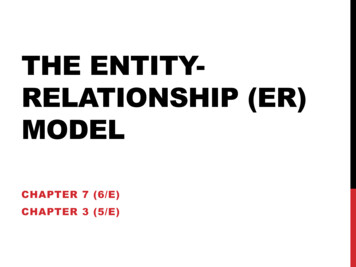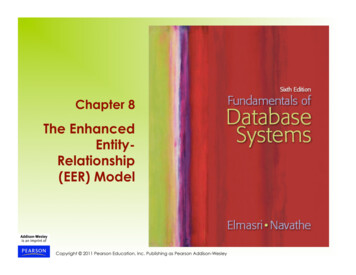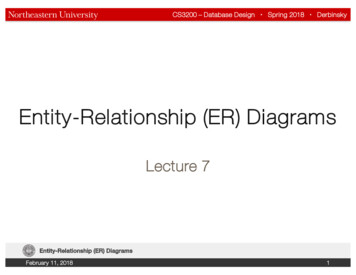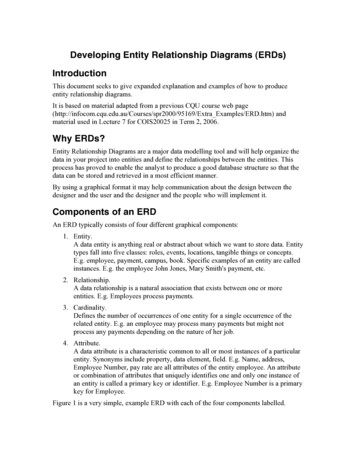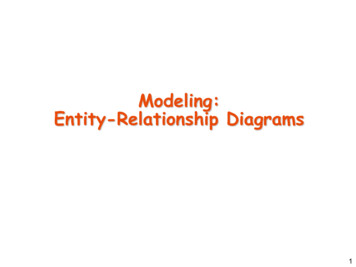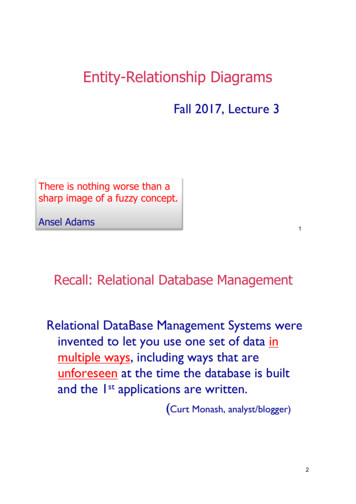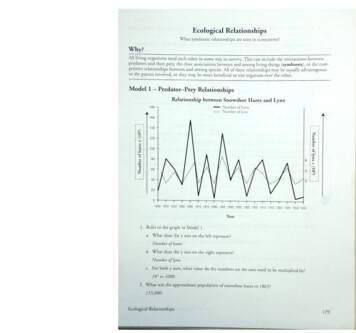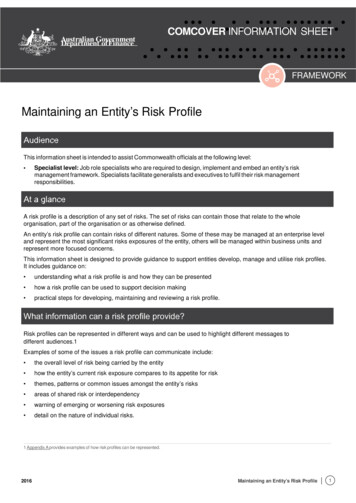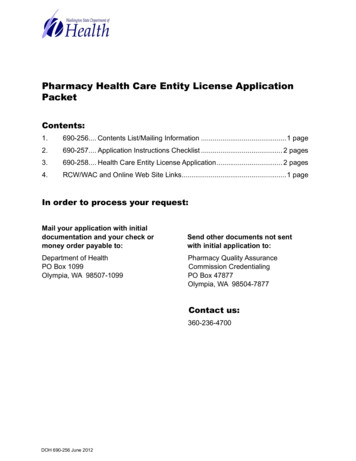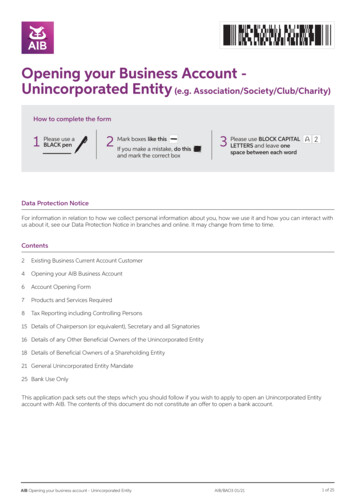
Transcription
Chapter 2: Entity-Relationship Model! Entity SetsEntity Sets! A database can be modeled as:! Relationship Sets" a collection of entities,! Design Issues" relationship among entities.! An entity is an object that exists and is distinguishable from other! Mapping Constraintsobjects.! Keys" Example: specific person, company, event, plant! E-R Diagram! Entities have attributes! Extended E-R Features" Example: people have names and addresses! Design of an E-R Database Schema! An entity set is a set of entities of the same type that share the! Reduction of an E-R Schema to Tablessame properties." Example: set of all persons, companies, trees, holidaysDatabase System Concepts2.1 Silberschatz, Korth and SudarshanDatabase System Concepts2.2Entity Sets customer and loancustomer-id customer- customer- customername streetcityloan- amountnumber Silberschatz, Korth and SudarshanAttributes! An entity is represented by a set of attributes, that is descriptiveproperties possessed by all members of an entity set.Example:customer (customer-id, customer-name,customer-street, customer-city)loan (loan-number, amount)! Domain – the set of permitted values for each attribute! Attribute types:" Simple and composite attributes." Single-valued and multi-valued attributes#E.g. multivalued attribute: phone-numbers" Derived attributesDatabase System Concepts2.3 Silberschatz, Korth and Sudarshan#Can be computed from other attributes#E.g. age, given date of birthDatabase System Concepts2.4 Silberschatz, Korth and Sudarshan
Relationship SetsComposite Attributes! A relationship is an association among several entitiesExample:Hayescustomer entitydepositorrelationship setA-102account entity! A relationship set is a mathematical relation among n 2 entities,each taken from entity sets{(e1, e2, en) e1 E1, e2 E2, , en En}where (e1, e2, , en) is a relationship" Example:(Hayes, A-102) depositorDatabase System Concepts2.5 Silberschatz, Korth and SudarshanDatabase System ConceptsRelationship Set borrower2.6 Silberschatz, Korth and SudarshanRelationship Sets (Cont.)! An attribute can also be property of a relationship set.! For instance, the depositor relationship set between entity setscustomer and account may have the attribute access-dateDatabase System Concepts2.7 Silberschatz, Korth and SudarshanDatabase System Concepts2.8 Silberschatz, Korth and Sudarshan
Degree of a Relationship Set! Refers to number of entity sets that participate in a relationshipset.! Relationship sets that involve two entity sets are binary (or degreetwo). Generally, most relationship sets in a database system arebinary.! Relationship sets may involve more than two entity sets."E.g. Suppose employees of a bank may have jobs(responsibilities) at multiple branches, with different jobs atdifferent branches. Then there is a ternary relationship setbetween entity sets employee, job and branchMapping Cardinalities! Express the number of entities to which another entity can beassociated via a relationship set.! Most useful in describing binary relationship sets.! For a binary relationship set the mapping cardinality must beone of the following types:" One to one" One to many" Many to one" Many to many! Relationships between more than two entity sets are rare. Mostrelationships are binary. (More on this later.)Database System Concepts2.9 Silberschatz, Korth and SudarshanDatabase System ConceptsMapping CardinalitiesOne to oneOne to many2.11 Silberschatz, Korth and SudarshanMapping CardinalitiesNote: Some elements in A and B may not be mapped to anyelements in the other setDatabase System Concepts2.10 Silberschatz, Korth and SudarshanMany to oneMany to manyNote: Some elements in A and B may not be mapped to anyelements in the other setDatabase System Concepts2.12 Silberschatz, Korth and Sudarshan
E-R DiagramsMapping Cardinalities affect ER Design! Can make access-date an attribute of account, instead of arelationship attribute, if each account can have only one customer! I.e., the relationship from account to customer is many to one,or equivalently, customer to account is one to many! Rectangles represent entity sets.! Diamonds represent relationship sets.! Lines link attributes to entity sets and entity sets to relationship sets.! Ellipses represent attributes! Double ellipses represent multivalued attributes.! Dashed ellipses denote derived attributes.! Underline indicates primary key attributes (will study later)Database System Concepts2.13 Silberschatz, Korth and SudarshanE-R Diagram With Composite, Multivalued, andDerived AttributesDatabase System Concepts2.15 Silberschatz, Korth and SudarshanDatabase System Concepts2.14 Silberschatz, Korth and SudarshanRelationship Sets with AttributesDatabase System Concepts2.16 Silberschatz, Korth and Sudarshan
RolesCardinality Constraints! We express cardinality constraints by drawing either a directed! Entity sets of a relationship need not be distinct! The labels “manager” and “worker” are called roles; they specify howemployee entities interact via the works-for relationship set.! Roles are indicated in E-R diagrams by labeling the lines that connectdiamonds to rectangles.! E.g.: One-to-one relationship:" A customer is associated with at most one loan via the relationship! Role labels are optional, and are used to clarify semantics of therelationshipDatabase System Conceptsline ( ), signifying “one,” or an undirected line (—), signifying“many,” between the relationship set and the entity set.borrower" A loan is associated with at most one customer via borrower2.17 Silberschatz, Korth and SudarshanDatabase System ConceptsOne-To-Many Relationship2.18 Silberschatz, Korth and SudarshanMany-To-One Relationships! In the one-to-many relationship a loan is associated with at mostone customer via borrower, a customer is associated withseveral (including 0) loans via borrowerDatabase System Concepts2.19 Silberschatz, Korth and Sudarshan! In a many-to-one relationship a loan is associated with several(including 0) customers via borrower, a customer is associatedwith at most one loan via borrowerDatabase System Concepts2.20 Silberschatz, Korth and Sudarshan
Participation of an Entity Set in aRelationship SetMany-To-Many Relationship! Total participation (indicated by double line): every entity in the entityset participates in at least one relationship in the relationship set! E.g. participation of loan in borrower is total! every loan must have a customer associated to it via borrower! Partial participation: some entities may not participate in anyrelationship in the relationship set! E.g. participation of customer in borrower is partial! A customer is associated with several (possibly 0) loansvia borrower! A loan is associated with several (possibly 0) customersvia borrowerDatabase System Concepts2.21 Silberschatz, Korth and SudarshanDatabase System ConceptsAlternative Notation for CardinalityLimits! Cardinality limits can also express participation constraints2.22 Silberschatz, Korth and SudarshanKeys! A super key of an entity set is a set of one or more attributeswhose values uniquely determine each entity.! A candidate key of an entity set is a minimal super key" Customer-id is candidate key of customer" account-number is candidate key of account! Although several candidate keys may exist, one of thecandidate keys is selected to be the primary key.Database System Concepts2.23 Silberschatz, Korth and SudarshanDatabase System Concepts2.24 Silberschatz, Korth and Sudarshan
Keys for Relationship SetsE-R Diagram with a Ternary Relationship! The combination of primary keys of the participating entity setsforms a super key of a relationship set." (customer-id, account-number) is the super key of depositor" NOTE: this means a pair of entity sets can have at most onerelationship in a particular relationship set.#E.g. if we wish to track all access-dates to each account by eachcustomer, we cannot assume a relationship for each access.We can use a multivalued attribute though! Must consider the mapping cardinality of the relationship setwhen deciding the what are the candidate keys! Need to consider semantics of relationship set in selecting theprimary key in case of more than one candidate keyDatabase System Concepts2.25 Silberschatz, Korth and SudarshanCardinality Constraints on TernaryRelationship! We allow at most one arrow out of a ternary (or greater degree)Database System Concepts2.26 Silberschatz, Korth and SudarshanBinary Vs. Non-Binary Relationships! Some relationships that appear to be non-binary may be betterrepresented using binary relationships" E.g. A ternary relationship parents, relating a child to his/her father andrelationship to indicate a cardinality constraint! E.g. an arrow from works-on to job indicates each employee workson at most one job at any branch.! If there is more than one arrow, there are two ways of defining themeaning." E.g a ternary relationship R between A, B and C with arrows to B and Cmother, is best replaced by two binary relationships, father and mother#Using two binary relationships allows partial information (e.g. onlymother being know)" But there are some relationships that are naturally non-binary#E.g. works-oncould mean" 1. each A entity is associated with a unique entity from B and C or" 2. each pair of entities from (A, B) is associated with a unique C entity,and each pair (A, C) is associated with a unique B" Each alternative has been used in different formalisms" To avoid confusion we outlaw more than one arrowDatabase System Concepts2.27 Silberschatz, Korth and SudarshanDatabase System Concepts2.28 Silberschatz, Korth and Sudarshan
Converting Non-Binary Relationships toBinary Form! In general, any non-binary relationship can be represented using binaryrelationships by creating an artificial entity set." Replace R between entity sets A, B and C by an entity set E, and threerelationship sets:1. RA, relating E and A2.RB, relating E and B! Also need to translate constraints" Translating all constraints may not be possible" There may be instances in the translated schema thatcannot correspond to any instance of R3. RC, relating E and C" Create a special identifying attribute for E" Add any attributes of R to E" For each relationship (ai , bi , ci) in R, create#1. a new entity ei in the entity set E2. add (ei , ai ) to RA3. add (ei , bi ) to RB4. add (ei , ci ) to RCDatabase System ConceptsConverting Non-Binary Relationships(Cont.)2.29 Silberschatz, Korth and SudarshanExercise: add constraints to the relationships RA, RB and RC toensure that a newly created entity corresponds to exactly one entityin each of entity sets A, B and C" We can avoid creating an identifying attribute by making E a weakentity set (described shortly) identified by the three relationship setsDatabase System Concepts2.30 Silberschatz, Korth and SudarshanDesign Issues! Use of entity sets vs. attributesChoice mainly depends on the structure of the enterprise beingmodeled, and on the semantics associated with the attribute inquestion.! Use of entity sets vs. relationship setsPossible guideline is to designate a relationship set to describe anaction that occurs between entities! Binary versus n-ary relationship setsAlthough it is possible to replace any nonbinary (n-ary, for n 2)relationship set by a number of distinct binary relationship sets, a nary relationship set shows more clearly that several entitiesparticipate in a single relationship.! Placement of relationship attributesDatabase System Concepts2.31 Silberschatz, Korth and SudarshanHow about doing an ER designinteractively on the board?Suggest an application to be modeled.
Weak Entity SetsWeak Entity Sets (Cont.)! An entity set that does not have a primary key is referred to as aweak entity set.! We depict a weak entity set by double rectangles.! We underline the discriminator of a weak entity set with adashed line.! The existence of a weak entity set depends on the existence of aidentifying entity set" it must relate to the identifying entity set via a total, one-to-many! payment-number – discriminator of the payment entity set! Primary key for payment – (loan-number, payment-number)relationship set from the identifying to the weak entity set" Identifying relationship depicted using a double diamond! The discriminator (or partial key) of a weak entity set is the set ofattributes that distinguishes among all the entities of a weakentity set.! The primary key of a weak entity set is formed by the primary keyof the strong entity set on which the weak entity set is existencedependent, plus the weak entity set’s discriminator.Database System Concepts2.33 Silberschatz, Korth and SudarshanWeak Entity Sets (Cont.)Database System Concepts2.34 Silberschatz, Korth and SudarshanMore Weak Entity Set Examples! In a university, a course is a strong entity and a course-offeringcan be modeled as a weak entity! Note: the primary key of the strong entity set is not explicitlystored with the weak entity set, since it is implicit in theidentifying relationship.! If loan-number were explicitly stored, payment could be made astrong entity, but then the relationship between payment andloan would be duplicated by an implicit relationship defined bythe attribute loan-number common to payment and loanDatabase System Concepts2.35 Silberschatz, Korth and Sudarshan! The discriminator of course-offering would be semester (includingyear) and section-number (if there is more than one section)! If we model course-offering as a strong entity we would modelcourse-number as an attribute.Then the relationship with course would be implicit in the coursenumber attributeDatabase System Concepts2.36 Silberschatz, Korth and Sudarshan
SpecializationSpecialization Example! Top-down design process; we designate subgroupings within anentity set that are distinctive from other entities in the set.! These subgroupings become lower-level entity sets that haveattributes or participate in re
customer entity relationship set account entity! A relationship set is a mathematical relation among n 2 entities, each taken from entity sets {(e 1, e 2, e n) e 1 E 1, e 2 E 2, , e n E n} where (e 1, e 2, , e n) is a relationship" Example: (Hayes, A-102) depositor Database System Concepts 2.7 Silberschatz, Korth and Sudarshan Relationship Set borrower Database .
